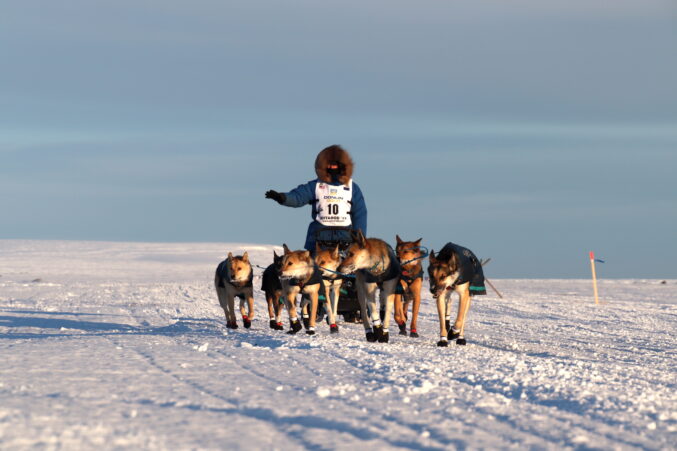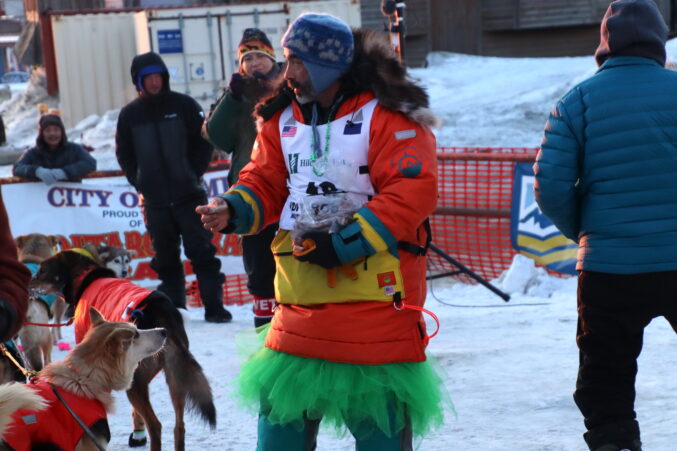Deke Naaktgeboren has completed his second Iditarod. He’s negotiated the Steps, the Gorge, and the snowless Burn. He’s navigated the sea ice and head winds of the Norton Sound and he’s persevered over Topkok and through the Blow Hole to finish in 29th place. Deke’s run time was 11 days, 4 hours and 12 minutes with an average speed of 3.59 mph. After being part of the Elim 11 in 2020, Deke was hoping for a faster less eventful run. He would have to be the judge of less eventful but his time improved by more than two days!
At the finish line Deke said, “Quite a journey and it’s good to be here. The wind was tough, I earned it today. There were no bad parts. It’s Iditarod, it’s challenging, it’s fun, I love it!”
Before moving to Alaska, Deke worked as a park ranger in the Everglades of Florida. Now he works for the BLM near Chicken, Alaska. He started mushing in 2008 and has completed numerous distance and mid-distance events since them. In his rookie run to Nome, Deke was held up in Elim due to impassible trail conditions with 10 other mushers, the Elim 11. Deke finished that race in 27th place with a time of 13 days, 18 hours and 48 minutes.
Matthew Failor has taken the last slot in the top 30 mushers. He arrived in Nome with a run time of 11 days, 5 hours and 51 minutes. He was the first of a trio of teams that arrived in Nome within 14 minutes of each other. That would definitely be a traffic jam in the finish chute! Failor has completed 10 of 11 Iditarod attempts, scratching only in 2020 just outside of Nome after encountering serious overflow along with Sean Underwood and Tom Knolmeyer.
At the finish line Matt commented on how special it was getting to Nome after having to scratch so close to the finish in 2020. He called the blow hole gnarly and was happy when Matt Paveglio came along. Matthew said he was getting blown around and knocking stuff down and then was able to follow Paveglio.
Matthew Failor apprenticed under Martin Buser and ran his first Iditarod with a Buser puppy team back in 2012. Matthew has participated in every Iditarod since, completing all but the 2020 race. Failor established 17th Dog Kennel in 2013. The name is a tribute to people who support their racing efforts. It used to be that mushers could run a 16 dog team, so fans and supporters of the team were considered the 17th Dog, a very important member of the team.
Rookie, Matt Paveglio snatched 31st place from Karin Hendrickson during the last ten miles of the trail. Paveglio was dressed for St. Patrick’s Day, wearing the green, for his first trip down Front Street. He earned the coveted finisher’s belt buckle with a time of 11 days, 6 hours and 0 minutes with an average speed of 3.57 mph. Matt’s daughter, Tietje, has taken to mushing like her father and has completed the Willow Jr. 100 as well as the Jr. Iditarod.
At the finish, Matt called the journey a religious experience. He said the challenges are nothing compared to what my patients go through. Even in the blow hole today, I was just out there playing with my dogs.
Matt Paveglia calls Eagle River, Alaska home. He arrived in Alaska from Lansing, Michigan in 2008. He has worked as a travel nurse and also in the Emergency room and Critical Care unit of an Anchorage hospital. Matt loves the out of doors and the opportunities for adventure that Alaska offers. He soon found himself on the runners of a sled and enjoyed working with Jim Lanier’s amazing canine athletes at Northern Whites Kennel. He is very thankful for the great friends and mentors he’s met through mushing.
Veteran Karin Hendrickson followed Paveglio into the chute by five minutes to earn 32nd place. Karin made the run in 11 days 6 hours and 6 minutes. She has completed 7 out of 10 Iditarod attempts with today’s being the highest place she’s achieved.
Under the arch, Karin said she didn’t really have one special dog but that lacking a leading many stepped up to fill the role. When asked if the race was special this year because of being so difficult, Karin responded that nothing will ever be as difficult as the 2014 race. That race was insane so after that I can say I’ve done something worse before. What kept Karin going? She replied, “We don’t quit, gotta get it done.”
Twenty years ago, Karin came to Alaska to volunteer for the Iditarod. That was a trip and experience that changed her life. She loved what she saw in the dogs, the people and the scenery. A year later she sold everything, quit her job in the lower 48, moved to Alaska and took a job as a handler. After handling for a couple of years, she re-evaluated and decided to quit dogs. But she was miserable. Her next step was to establish Black on Blue Kennel for recreational mushing. Two years later she was signing up for Iditarod! The rest is history.
Karin was hit by a truck on a training run in 2014. The dogs were uninjured but Karin sustained three spinal fractures. She says, “It has been a real challenge to work through the pain and overcome the loss of function. But I wasn’t ready to quit doing what I love – running dogs in the amazing wilderness of Alaska.” Karin’s grit and determination is very inspiring!



































